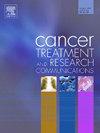利用循环肿瘤细胞调整晚期胰腺癌的二线治疗:初步结果
IF 2.4
Q3 Medicine
引用次数: 0
摘要
背景:晚期胰腺癌(APC)的最佳二线(2L)化疗方案仍然没有答案。我们的目的是评估循环肿瘤细胞(ctc)在APC的2L治疗方案中的有效性。方法对17例一线治疗无效的APC患者(实验组)的ctc进行分析。根据对患者分离的ctc进行的几种化疗药物的化疗敏感性/生存能力测定,建议对每位患者进行2L治疗。以中位生存期(MS)为主要终点,比较实验组的生存曲线与2个2L最佳支持治疗(2L- bsc)组(分别为23例和18例)的重构生存曲线。此外,利用多篇论文发表的2L-BSC汇总统计数据(中位数)进行meta分析,估计合并加权MS,并与实验组的估计MS进行比较。最后,采用LR、RMST等统计学检验,检验实验组与2个2L-BSC组之间差异的统计学意义。结果治疗组(7个月)MS明显高于2个2L-BSC组(分别为2.29个月和2.4个月)。这一结果得到了支持,因为加权MS是在2.70个月时发现的。结果具有统计学意义。结论基于ctc体外应答的2L治疗与2L- bsc治疗相比,延长了APC患者的MS,可能会导致更有效的2L APC治疗方案的开发。本文章由计算机程序翻译,如有差异,请以英文原文为准。
Second-line therapy adjustment for advanced pancreatic cancer using circulating tumor cells: Preliminary results
Background
The determination of the optimal second-line (2L) chemotherapy for advanced pancreatic cancer (APC) is still unanswered. We aimed to assess the effectiveness of circulating tumor cells (CTCs) in proposing 2L treatments for APC.
Methods
We analyzed CTCs from 17 patients (experimental group) with APC, for whom first-line treatment was ineffective. Based on chemosensitivity/viability assays on several chemotherapeutic drugs, which were performed on CTCs isolated from patients, a 2L treatment was proposed for each patient. Median survival (MS) was used as the primary endpoint to compare the survival curve of the experimental group with the reconstructed survival curves of two 2L best supportive care (2L-BSC) groups with 23 and 18 patients, respectively. Moreover, using a meta-analysis of 2L-BSC summary statistics (medians) published in various papers, a pooled weighted MS was estimated and compared with one estimated for the experimental group. Finally, the statistical significance of the difference between the experimental and the two 2L-BSC groups was examined by applying statistical tests, like LR and RMST.
Results
The MS for the treatment group (7 months) was found to be greater than the MS of the two 2L-BSC groups (2.29 and 2.4 months, respectively). This result was supported since the weighted MS was found at 2.70 months. The results were found statistically significant.
Conclusions
The preliminary results indicate that 2L treatment based on CTCs’ response in vitro prolongs MS of APC patients compared with 2L-BSC-treated ones, potentially leading to the development of more effective 2L APC therapy plans.
求助全文
通过发布文献求助,成功后即可免费获取论文全文。
去求助
来源期刊

Cancer treatment and research communications
Medicine-Oncology
CiteScore
4.30
自引率
0.00%
发文量
148
审稿时长
56 days
期刊介绍:
Cancer Treatment and Research Communications is an international peer-reviewed publication dedicated to providing comprehensive basic, translational, and clinical oncology research. The journal is devoted to articles on detection, diagnosis, prevention, policy, and treatment of cancer and provides a global forum for the nurturing and development of future generations of oncology scientists. Cancer Treatment and Research Communications publishes comprehensive reviews and original studies describing various aspects of basic through clinical research of all tumor types. The journal also accepts clinical studies in oncology, with an emphasis on prospective early phase clinical trials. Specific areas of interest include basic, translational, and clinical research and mechanistic approaches; cancer biology; molecular carcinogenesis; genetics and genomics; stem cell and developmental biology; immunology; molecular and cellular oncology; systems biology; drug sensitivity and resistance; gene and antisense therapy; pathology, markers, and prognostic indicators; chemoprevention strategies; multimodality therapy; cancer policy; and integration of various approaches. Our mission is to be the premier source of relevant information through promoting excellence in research and facilitating the timely translation of that science to health care and clinical practice.
 求助内容:
求助内容: 应助结果提醒方式:
应助结果提醒方式:


